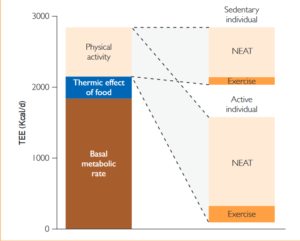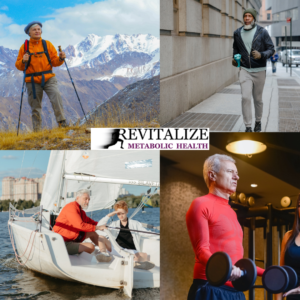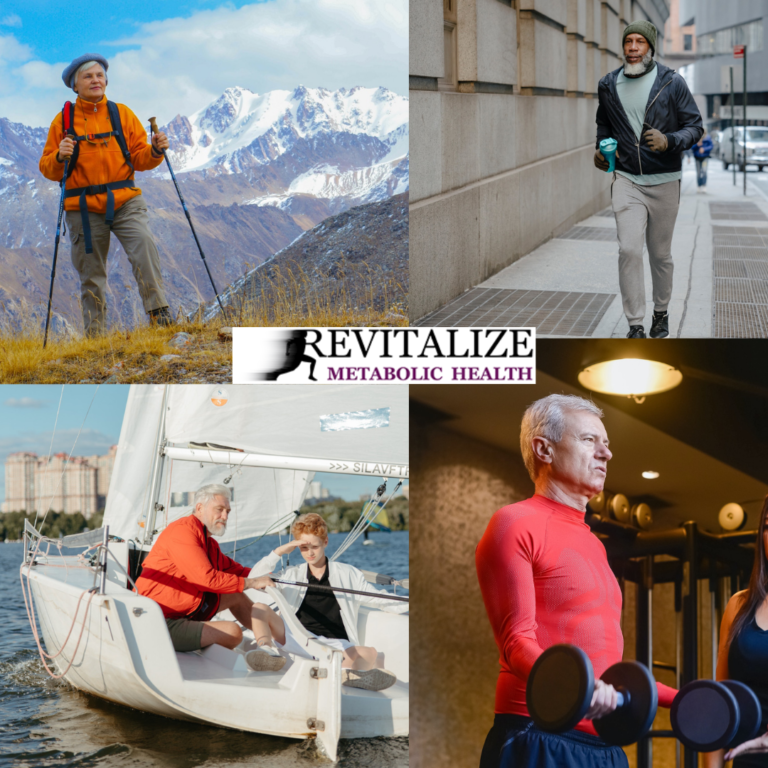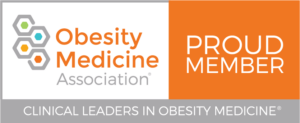Importance of Physical Activity
Physical activity has long been recognized as an important tool for weight loss and overall health, and it is increasingly appreciated that any movement is beneficial, not just the dedicated exercise routines performed in a gym or fitness center.

The cumulative amount of energy we use for physical activity other than dedicated exercise is called Non-Exercise Activity Thermogenesis (NEAT). NEAT often accounts for the largest variation in energy expenditure among individuals and may explain the perception that some people can more easily maintain their weight or are “naturally skinny” despite similar food intake and dedicated exercise.
Components of Total Energy Expenditure (TEE). Note the theoretical variation in NEAT that could be observed between sedentary and active individuals.
Unfortunately, the modern world is engineered in ways that encourage sedentary behavior and more sitting. For example, there has been explosive growth of drive-thru restaurants and office cubicles since the 1960’s. Urban sprawl and city designs with poor walkability or limited public transportation options have driven increased usage of cars over walking. Furthermore, there are countless other labor-saving devices and machines that have replaced the need for physical labor. It is estimated that ¼ of all adults sit for more than 8 hours per day.
The Perils of Inactivity
The impact of these cultural shifts on our health has contributed to the notion that “sitting is the new smoking.” Indeed, prolonged sitting is associated with chronic diseases, decreased functional status, and increased mortality.
Research demonstrates that people who sit more have greater body fat than those who are more active. People with obesity tend to sit for 2 ¼ more hours per day than lean people with similar professions, economic status, and home environments.
Chronic sedentary behavior (sitting, TV viewing, couch time) is associated with increased risk of at least 35 conditions and increased mortality rates, seen below with related conditions grouped together:
- Accelerated aging
- Frailty in the elderly
- Muscle loss/Sarcopenia
- Arthritis
- Blood clots
- Obesity; weight regain after weight loss
- Diabetes
- Metabolic Syndrome/Insulin Resistance
- Hypertension
- Abnormal lipids/cholesterol
- Fatty liver
- Vascular disease: Heart Disease, Stroke, Peripheral Arterial Disease
- Heart failure
- Cancer – breast, colon, endometrial, prostate
- Osteopenia/Osteoporosis
- Erectile dysfunction
- Depression/Anxiety
- Chronic pain
- Dementia
Thrive as you age

Chronic diseases are not necessarily an inevitable part of aging, and we should not accept that notion. Physical activity, especially combined with nutrition and other aspects of health, can prevent/delay/reverse these disease processes as well as the effects of aging.
In addition to protecting us against chronic disease, physical activity helps to improve: body composition, insulin sensitivity, mobility, resilience to stressors, cognition, bone health, pain, and mood. It’s never too late to become physically active. Even initiating exercise in one’s 80’s after a lifetime of sedentary behavior has shown benefit in terms of strength, functional status, and longevity.
Ways to increase physical activity
There are many ways to increase your physical activity without dedicated exercise:
- Take the stairs rather than elevators
- In parking lots, park your car further from the building entrance
- Use a standing desk or table
- Go for regular walks. Walk your dog.
- Schedule walking meetings; walk during phone calls
- Explore your neighborhood on foot
- Live near where you work; work near where you live
- Use a treadmill or exercise bike while watching TV
- Take regular breaks from sitting, e.g. every 20-30 minutes
- Take your kids outside
- Do yard work
- Just keep moving





